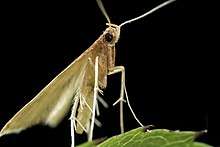Thambotricha
| Thambotricha | |
|---|---|
 | |
| Scientific classification | |
| Kingdom: | Animalia |
| Phylum: | Arthropoda |
| Class: | Insecta |
| Order: | Lepidoptera |
| Family: | Epermeniidae |
| Genus: | Thambotricha |
| Species: | T. vates |
| Binomial name | |
| Thambotricha vates Meyrick, 1922[2] | |
Thambotricha is a monotypic genus of moths in the family Epermeniidae. Its sole known species, Thambotricha vates, is also known by the vernacular name wonder-haired prophet. It is endemic to New Zealand. This species is classified as "At Risk, Naturally Uncommon" by the Department of Conservation.
Taxonomy and etymology
T. vates was described by Edward Meyrick in 1922 from a specimen collected in Wellington by C. E. Clarke.[3] George Hudson discussed and illustrated the species in his 1928 book The Butterflies and Moths of New Zealand.[4] The holotype specimen is held at the Natural History Museum, London.[5] The vernacular name of this species, "wonder-haired prophet", comes from a translation of its latin name.[6] The name is as a result of the male having very long hairs on its antenna.[6]
Description
Meyrick described the species as follows:
♂︎ 14mm. Head pale ochreous, side-tufts bronzv. Palpi bronzy-fuscous. Antennal ciliations 8. Thorax purple-bronzy-ochreous. Abdomen whitish-ochreous. Fore wings elongate, narrowed towards base, costa sinuate, apex pointed, termen faintly sinuate, oblique ; pale yellow overlaid with purple-bronzy-ochreous, costal edge pale yellow from 2⁄5 to 4⁄5 ; discal stigmata remote, rather dark fuscous, an additional dot beneath and rather before second, these two partially surrounded with pale yellowish ; a slender terminal streak of purple-fuscous suffusion ; cilia whitish-yellowish, on costa suffused purple-ochreous, darkest above apex, on dorsum pale ochreous tinged purple, cilia extending to before middle of dorsum. Hind wings and cilia ochreous-whitish.[3]
Distribution
This species is endemic to New Zealand.[2][7] Along with its type locality of Gollan's Valley in Wellington,[4] this moth has also been collected at the Waipoua State Forest in Northland,[8] in the Hakarimata Range near Ngaruawahia in the Waikato,[8] in Taranaki,[9] at Katikati in the Bay of Plenty,[6] and near Aorere River in Nelson.[4]
Biology and life cycle
Little is known of the biology of this species.[6][10] T. vates are on the wing in March.[3] This species appears not to attracted to light and has been caught by sweeping during daytime.[6][8] Males of the species have been however been collected at night with the use of a pressure lamp.[8]
Host species and habitat
The host species of the larvae of this moth is unknown.[6][10] This species prefers native forest habitat.[6]
Conservation status
This species has been classified as having the "At Risk, Naturally Uncommon" conservation status under the New Zealand Threat Classification System.[11]
References
| Wikimedia Commons has media related to Thambotricha. |
- ↑ Beccaloni, G.; Scoble, M.; Kitching, I.; Simonsen, T.; Robinson, G.; Pitkin, B.; Hine, A.; Lyal, C., eds. (2003). "Thambotricha". The Global Lepidoptera Names Index. Natural History Museum. Retrieved April 23, 2018.
- 1 2 "Thambotricha vates Meyrick, 1922". www.nzor.org.nz. Landcare Research New Zealand Ltd. Retrieved 2018-04-02.
- 1 2 3 Meyrick, Edward (1922). "A new genus and species of Microlepidoptera from New Zealand". The Entomologist. 55: 270-271. ISSN 0013-8878. Retrieved 26 May 2018.
- 1 2 3 Hudson, G. V. (1928). The Butterflies and Moths of New Zealand. Wellington: Ferguson & Osborn Ltd. p. 325.
- ↑ Dugdale, J. S. (1988). "Lepidoptera - annotated catalogue, and keys to family-group taxa" (PDF). Fauna of New Zealand. 14: 1–262.
- 1 2 3 4 5 6 7 "Elusive moth found in Bay of Plenty". Stuff. 22 April 2015. Retrieved 3 April 2018.
- ↑ Gordon, Dennis P., ed. (2010). New Zealand inventory of biodiversity. Volume two. Kingdom animalia : chaetognatha, ecdysozoa, ichnofossils. Vol. 2. Christchurch, N.Z.: Canterbury University Press. p. 458. ISBN 9781877257933. OCLC 973607714.
- 1 2 3 4 Dugdale, J. S. (2 February 2012). "Thambotricha vates Meyrick, reassigned to Epermeniidae (Lepidoptera: Epermenioidea)". New Zealand Journal of Zoology. 14 (3): 375–383. doi:10.1080/03014223.1987.10423008.
- ↑ Bath, Brooke (2015-04-21). "Rare moth causes a flutter in Katikati". NZ Herald. ISSN 1170-0777. Retrieved 2018-04-02.
- 1 2 Patrick, Brian; Dugdale, John S. (2000). Conservation status of the New Zealand lepidoptera (PDF). Wellington, N.Z.: Department of Conservation, New Zealand. p. 32. ISBN 0478218672. OCLC 154670803.
- ↑ Hoare, R.J.B.; Dugdale, J.S.; Edwards,, E.D.; Gibbs, G.W.; Patrick, B.H.; Hitchmough, R.A.; Rolfe, J.R. (2017). "Conservation status of New Zealand butterflies and moths (Lepidoptera), 2015" (PDF). New Zealand Threat Classification Series. 20: 9.